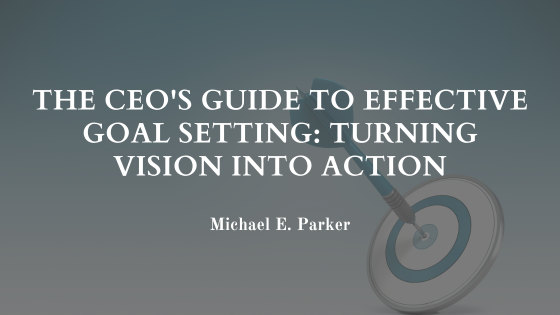In the dynamic landscape of modern business, where change is the only constant, effective goal-setting stands as the cornerstone of success. For CEOs navigating the complexities of leadership, translating vision into tangible action requires a strategic approach to goal setting that is both dynamic and disciplined. The following blog provides a CEO’s guide to effective goal setting, offering insights and strategies to turn vision into action.
- Define Clear Objectives: The journey toward success begins with clarity. As a CEO, it’s essential to define clear and specific objectives that align with the overarching vision of the organization. These objectives should be SMART (Specific, Measurable, Achievable, Relevant, and Time-bound), providing a roadmap for progress while ensuring accountability at every stage.
- Cultivate a Culture of Alignment: Effective goal setting extends beyond the boardroom; it permeates the organizational culture. CEOs must foster alignment across all levels of the company, ensuring that every employee understands their role in achieving the collective goals. By fostering a culture of alignment, CEOs can harness the collective power of their teams to drive progress and innovation.
- Embrace Flexibility: While setting clear objectives is essential, it’s equally crucial to embrace flexibility in the pursuit of those goals. In today’s fast-paced business environment, unforeseen challenges and opportunities are inevitable. CEOs must be willing to adapt their goals and strategies in response to changing circumstances, remaining agile in the face of uncertainty.
- Lead by Example: Effective goal setting begins with leadership. CEOs must lead by example, demonstrating a commitment to goal achievement through their actions and decisions. By embodying the values of discipline, resilience, and accountability, CEOs inspire confidence and motivation among their teams, driving momentum toward success.
- Utilize Data-driven Insights: In the age of digital transformation, data has emerged as a powerful tool for informed decision-making. CEOs can leverage data-driven insights to refine their goal-setting process, identifying trends, opportunities, and areas for improvement with precision and accuracy. By harnessing the power of data, CEOs can make strategic decisions that propel their organizations forward.
- Encourage Collaboration and Innovation: Effective goal setting thrives on collaboration and innovation. CEOs should create an environment where employees feel empowered to share ideas, experiment with new approaches, and challenge the status quo. By fostering a culture of both collaboration and innovation, CEOs can help to unlock the full potential of their teams, driving creativity and problem-solving across the organization.
- Celebrate Milestones and Learn from Setbacks: Along the journey towards goal achievement, it’s essential to celebrate milestones and learn from setbacks. Recognizing progress not only boosts morale but also reinforces the commitment to success. Likewise, setbacks should be viewed as valuable learning opportunities, providing insights that inform future strategies and actions.
Effective goal setting is the key to turning vision into action for CEOs. By defining clear objectives, cultivating a culture of alignment, embracing flexibility, leading by example, utilizing data-driven insights, encouraging collaboration and innovation, and celebrating milestones, CEOs can chart a course toward sustainable success in today’s dynamic business landscape.
